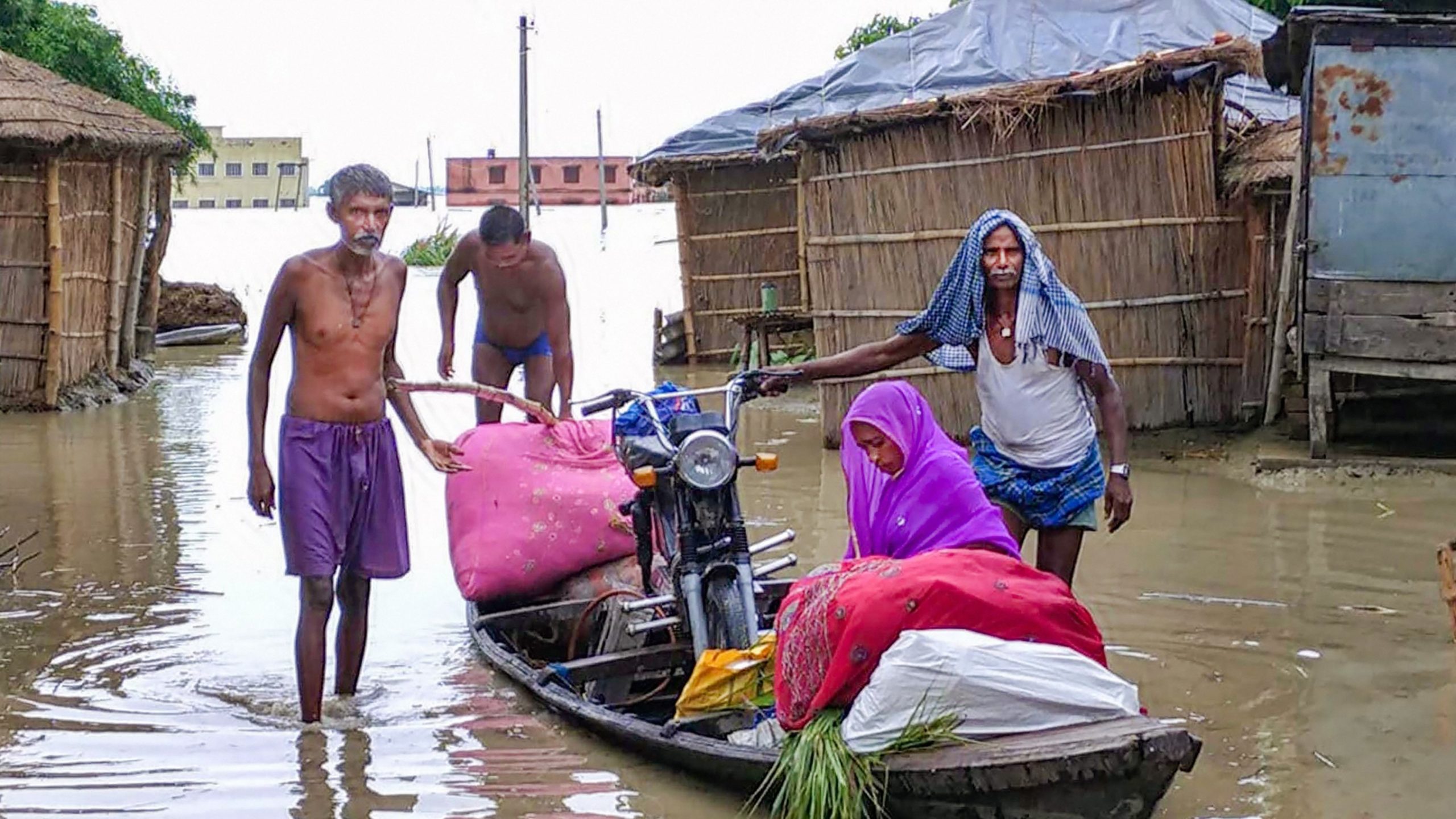Bihar flood situation worsens as embankments of the Gandak river breach, about a million affected
At least three breaches reported in the embankments of river Gandak in north Bihar leading to inundation of hundreds of villages in Gopalganj and East Champaran districts.


On July 24, Saran embankment in Gopalganj breached, villagers woke up to massive floods. Photo: Twitter All India Radio News
Yesterday, in the wee hours of July 24, tens of thousands of villagers in Gopalganj district of Bihar woke up in shock as flood waters entered their villages and homes. Soon the most-feared news of the monsoon spread and villagers realised the embankment of Gandak river, also known as Saran embankment, had breached at two places (near Devapur and Puraina villages) leading to large volumes of water gushing into the villages with full force.
This is not all. Soon the news of another breach in the eastern embankment of Gandak, downstream of Saran embankment (which is the western embankment of the river), was reported near Bhawanipur village leading to massive floods in East Champaran district.
As per the state water resources department, at least 1,700 hectares (ha) area in Gopalganj and 3,550 ha in East Champaran is expected to be inundated in the fresh wave of floods. The National Disaster Response Force is working round the clock to rescue the flood-affected people.
Meanwhile, the state disaster management department has informed a total of 9.60 lakh people are affected by floodwaters in 529 panchayats of 74 blocks in 10 districts. These floods are a result of heavy rainfall in the state and also in Nepal from where the Himalayan rivers flow down into north Bihar making the state India’s most flood-prone state. Nepal is also facing massive floods and has already reported 132 deaths.
“Around two in the morning, the Saran embankment breached. Within no time several villages were flooded. We spent the whole day rescuing around 650 people in Devapur, Barauli and nearby villages,” Neelu Kumari, a resident of Gopalgunj, who is associated with Kalpana Vikas Mahila Mandal, a local non-profit organisation, told Gaon Connection.
A number of local people are blaming Nepal for releasing excess water in Gandak river (known as Gandaki in the Himalayan state). “The embankment breached because of the water released by Nepal. Villagers in the affected places are being moved towards safer places. This cycle seems unending,” Abhishek Kumar, another local resident of Gopalgunj told Gaon Connection.
Flood forecast data of the state water resources department shows the huge volume of water released between July 21-22 in Gandak river at Valmikinagar in West Champaran where the river enters India (Bihar) from Nepal. As against the daily discharge of 150,000-200,000 cusecs water a day till July 20, the water released on July 22 crossed 500,000 cusecs.

Predictably, the swollen river has inundated downstream villages and breached its embankments, which are expected to ‘protect’ people from floods, but often end up causing catastrophic flash floods.
“Recently, over four lakh cusecs water was released from the Valmiki Barrage, and one-two lakh cusecs water is being released almost every day. How can the barrage contain so much water pressure? Water will obviously flow downstream and affect us,” Vinay Kumar, a resident of Jagdishpur in Paschim (West) Champaran, told Gaon Connection. He is also the secretary of a local non-profit, Water Action, which works on water and sanitation issues.
According to him, a number of villages in Paschim Champaran district are also water-logged, and villages along the India-Nepal border are facing regular flash floods.
“As of now, the Gandak’s eastern embankment has breached in Gopalganj. But, it is quite likely the western embankment also breaches causing major floods in Pashchim Champaran,” feared Kumar. “It has been raining here for the last 15 days. Villages are inundated and people are running for their lives,” he added.
As per the weather forecast, more rains are expected in the state next week, which may further worsen the flood scenario.

Embankments breaches during peak monsoon season are reported regularly in Bihar. “This time the Saran embankment has breached at two places in Gopalganj. But, it’s not the first time the embankment breached at that location. Earlier, it had breached at the same place in 2001, too,” Pradeep Poddar, a resident of Saharsa, and programme officer with Megh Pyne Abhiyan, a local non-profit working on water and floods in north Bihar, told Gaon Connection.
“At present at least 500 villages are affected due to Saran embankment breach,” he added.
Last year, around the same time in July, the western embankment of Kamla Balan river had breached under pressure from the rising flood waters and inundated many villages including Naruar village in Madhubani district, washing away everything that came in its way, including the cement and brick structures. The flood-affected are still living under tarpaulins near the embankment.
Every year the state government prepares Standard Operating Procedures that includes pre and post flood preparations. It is a set of guidelines that includes various flood fighting measures, maintenance of embankments/barrages, setting up of relief camps and others. Despite that, several reports of embankment breaches are observed.

“Between 2000 and 2018, embankments of different rivers in Bihar have breached on innumerable occasions, for instance 2004, 2007, 2008, 2010, 2013, 2017, to name a few. The state government efforts have regularly been deluged by breaches in the embankments since past five decades,” Eklavya Prasad, managing trustee of Megh Pyne Abhiyan, told Gaon Connection.
Bihar is no stranger to floods. It is India’s most flood-prone state — more than 17 per cent of the country’s total flood-prone area is in Bihar. Of its total 38 districts, 28 are categorised as flood-prone by the water resources department of the Bihar government.
Simply put, 73 per cent of the total geographical area of the state is prone to floods.
In spite of Bihar being geographically and historically prone to floods, the state government is almost always caught unaware when the disaster strikes.
In the name of flood control, the state government has embanked all the major rivers of the state by constructing tall earthen dams all along their flow. But, rather than controlling floods, these embankments seem to have increased the flood affected area.
For instance, in 1954, Bihar’s flood prone area was 2.5 million hectares (mha) and the state had only 160 kms of embankments. During the 1974 floods, Bihar had 2,192 kms of embankments and its flood prone area had increased to 4.26 mha.
Thirteen years later, in 1987 floods, the state prided itself in 3,321 kms of embankments, but the flood prone area had shot up to 6.461 mha. The year 2004 brought one of the worst floods, killing 885 people. By then, Bihar had 3,465 kms long embankments and a flood prone area of 6.88 mha.

As the length of embankments has increased in Bihar, so has the flood-prone area.
“The state’s flood control strategy is primarily structural in character, in other words embankment-based. This has destroyed the natural flow regime of the rivers, and has transformed the flood intensity, frequency and pattern,” said Prasad. In addition it has also created a ‘false sense of security’ amongst the people living in the supposedly ‘flood free zone’, he added.
According to him, the containment of great volumes of water due to the construction of embankments along the rivers, and the flow of sediment from the Himalayan catchments, has further complicated the flooding problem in North Bihar. The obsession for structural, technical, infrastructural, capital intensive, and contractual driven strategy has been the most damaging for the people of North Bihar.
“It is time to propose a comprehensive review of all the embankments in the state, followed by reallocating priorities between structural flood control and non-structural flood management measures,” recommended Prasad.

